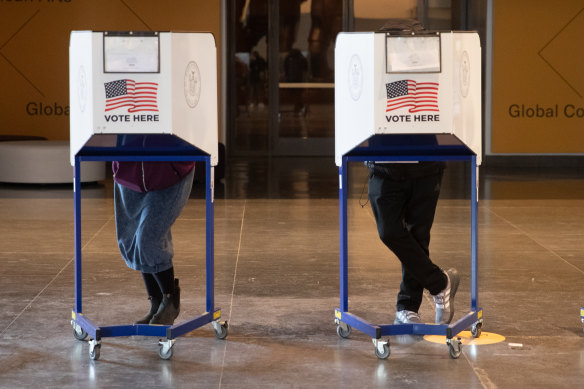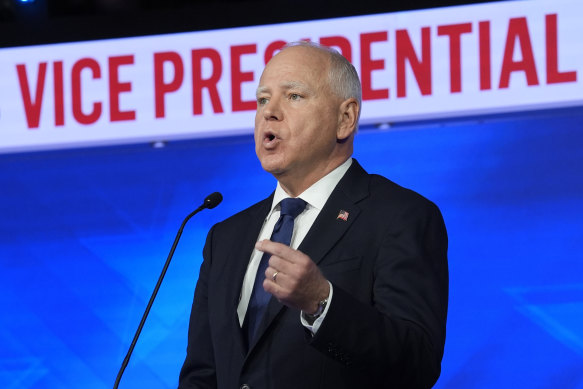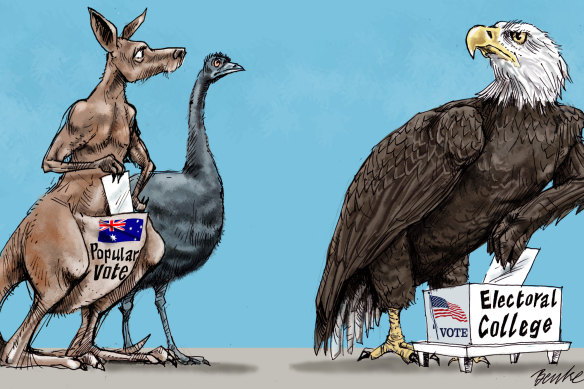This was published 5 months ago
Opinion
160 million Americans will vote. Only 538 will choose the next president
Peter Hartcher
Political and international editorIt’s possible that the US electoral system is perfect. How would we know when perfection had been attained? According to the great American journalist and pundit of the early 20th century, H.L. Mencken: “As democracy is perfected, the office of president represents, more and more closely, the inner soul of the people. On some great and glorious day the plain folks of the land will reach their heart’s desire at last and the White House will be adorned by a downright moron.”
Many would argue that the US had already satisfied this test some years ago, and may be in the process of satisfying it once again. But most Americans don’t think their system is perfect. When the Democrats’ candidate for the vice presidency, Tim Walz, this week called for the abolition of the Electoral College, almost two-thirds of voters would have agreed with him, according to a Pew poll on the question last month.

Voters cast ballots in the 2020 election. Credit: Bloomberg
Because, while some 160 million Americans are expected to vote on November 5, they are not the people who actually will elect the next president and vice president. A mere 538 Americans get to make that choice. They are the members of the Electoral College. And they, in turn, are chosen by the legislatures of the 50 states plus the District of Columbia.
The American people have no direct say in this system, a creation of the US Constitution. Indeed, the Constitution doesn’t even mention any role for the American voting public in choosing the president and vice president.
This central reality is blithely overlooked in most of the coverage, in the US itself and abroad, of the election. The breathless, near-daily reporting of the national opinion polls, for instance, is framed as if it matters. It doesn’t much, unless the popular vote is a tsunami-sized majority for one candidate, which is most unlikely.
That’s why Hillary Clinton was able to win almost 3 million votes more than Donald Trump in 2016, yet lose the election. Because Trump won most of the Electoral College. And why Al Gore could win half a million votes more than George W. Bush in 2000 yet still lose the election. There have been three other such elections where the winner of the popular vote has lost the count that matters; in 1824, 1876 and 1888.
Seems unfair? “It may have made sense in the 18th century when our identities were primarily local and state-based, but at least since the Civil War we have thought of ourselves as Americans,” explains David Greenberg, professor of US history at Rutgers University. “People do understand the fundamental unfairness of the Electoral College for our times. It’s a relic of another era.”
That’s why most Americans want to ditch it. “I think all of us know, the Electoral College needs to go,” Walz told a gathering of Democrat donors. “We need a national popular vote.”
Honest. But in the heat of an election campaign, unwise. Walz’s comment could be used to suggest that the Democrats want to move the election goalposts mid-game. Until now, Trump is the only candidate who’s refused to commit to respecting the election result, much as he refused to accept the 2020 result. But now Trump can argue that the Democrats are laying the groundwork for rejecting the result if they lose in the Electoral College. Trump’s campaign pounced: “Why does Tampon Tim hate the Constitution so much?”
In case you were wondering about the nickname, Trump calls Walz “Tampon Tim” because, as Minnesota governor, he approved a bill requiring that all public schools in the state provide free menstrual pads and tampons to students. Far from being insulted, Walz wears this nickname as a badge of pride.

“Tampon Tim” wears his nickname as a badge of pride. Credit: AP
“Nothing screams ‘we are going to lose’ more than saying the game was rigged in the first place,” former Trump chief of staff Mick Mulvaney wrote in The Hill. “Some people might call it ‘undermining democracy’” to challenge the legitimacy of the Electoral College.
Suddenly, it wasn’t just Trump who looked like an election denier. So the Harris-Walz campaign, including Walz himself, quickly backpedalled on his comment about the Electoral College.
“Ever since Bush v Gore, Americans think it’s unfair because it helps Republicans disproportionately,” Greenberg tells me. This hasn’t always been the case. In some earlier times, it has favoured Democrats. But “in the modern period, Republicans should be expected to win 65 per cent of presidential contests in which they narrowly lose the popular vote”, according to a 2019 study by three economics researchers at the University of Texas led by Michael Geruso.
Why does it favour the Republican candidate? Because the founders structured the Electoral College deliberately to give an advantage to small states. And, at the moment, this is a pro-Republican factor. The bias to small states was part of the so-called Great Compromise to persuade the less populous states, fearful of being trampled perpetually by the more populous, to join.
Specifically, the number of Electoral College votes allocated to a state is determined by its number of House of Representatives districts, plus two. For the smallest states like Delaware or North Dakota, which have only one district, the “plus two” has the effect of tripling their voting power, while having scant effect on the bigger states’ share.
The inherently undemocratic effect of this is accentuated by the fact that, in almost every state, a state awards all of its Electoral College votes after each election to the party that won the majority of the popular vote in that state. It’s a “winner-takes-all” system rather than a proportionate one.
So the Democrats might win 48 per cent of the popular vote in a state, for example, but that state will award 100 per cent of its Electoral College votes to the winning party, the Republicans. Maine and Nebraska are the exceptions; they split their Electoral College votes in proportion to the parties’ share in the popular vote.
One effect of this system is to concentrate the election contest into a handful of so-called “battleground” or swing states. In this election, there are seven – Arizona, Georgia, Michigan, Nevada, North Carolina, Pennsylvania and Wisconsin – where it will be decided.
What are the prospects for Kamala Harris and Trump in the Electoral College at the moment? The winner will be the first to garner 270 of the 538 Electoral College votes, a simple majority. The state of play is that, according to 270towin.com, the Democrats are likely to win 226 and the Republicans 219, based on the expert consensus on the projected popular vote state by state. That leaves 93 Electoral College votes in the balance. Too close to call, in other words.
Americans are conscious that this archaic system is flawed; there have been about 700 attempts to dump or change it over the centuries, according to the University of California, Berkeley. The last serious one was in the 1970s. Yet it stands.
As an Australian who’s observed US politics for 40 years, including on a posting to Washington and during a recent visit, I have a renewed appreciation for Australia’s electoral system. Above and beyond any particular features, Australia is well served by its preparedness to evolve with the times. From the outset, it has been an electoral innovator. For example, Australia invented the secret ballot, which was long known abroad as the “Australian ballot”. It was the first country to allow women to stand for parliament, thanks to South Australia, and the second to allow women to vote, after New Zealand.
Today, the Australian system has three design features that set it apart from and above America’s.

Illustration: Joe BenkeCredit:
The first is mandatory voting, a system Barack Obama forlornly wished the US might one day adopt. When everyone votes, the political parties must appeal to the centre for support. That keeps the debates centrist and broadly rational. The election outcomes are more representative of the population as a whole. This wasn’t an original feature; it was introduced in 1924. In the US, the parties pursue voter turnout with hot-button appeals on hyper-emotional issues. That’s why they’re campaigning today on abortion and mass deportations.
The second feature is an independent, national election administrator. We call it the Australian Electoral Commission. So the rules are uniform, voting is fair and seat boundaries drawn neutrally. In the US, every state has a different system operated politically, voting rules vary wildly and seats are gerrymandered grotesquely.
Third is Australia’s system of preferential voting. The overall effect is to favour the stability of a two-party system. While that’s a disadvantage to fringe parties, it doesn’t exclude them altogether. It also means that few votes are “wasted” and results are more closely aligned with popular will. Again, this wasn’t an original feature. It was introduced in 1918.
No system is perfect. Australia will benefit by continuing to be willing to evolve. The Albanese government’s promised reforms to political finance, for example, are a necessary corrective of a kind that the US, with its constitutional fundamentalism, has been unable to achieve.
No system can legislate against a downright moron, but we can try to minimise the risks.
Peter Hartcher is international and political editor.
Get a US election wrap-up every Tuesday plus a Thursday note from our foreign correspondents on what’s making news around the world. Sign up for our What in the world newsletter.